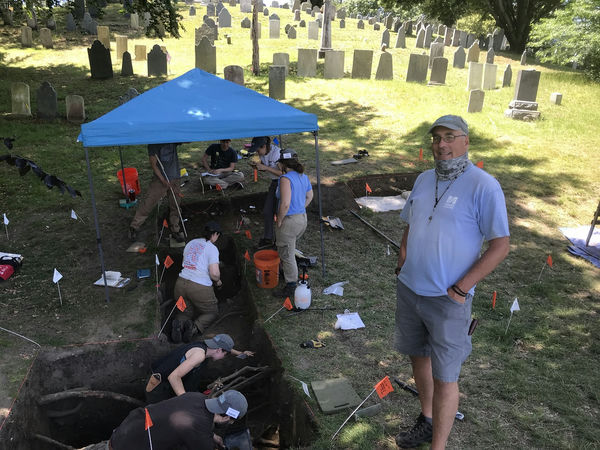
The town of Plymouth had been expecting a big tourist year in 2020 to commemorate its 400th anniversary. Needless to say, that didn’t happen. Instead it brought back memories of the “Great Dying” that Native Americans experienced when European diseases ravaged the northeast coast just prior to the arrival of the Pilgrims. The town of Plymouth had been planning to open a new memorial on Cole’s Hill above Plymouth Rock to be called Remembrance Park in memory of both the Wampanoag and Pilgrim losses four centuries ago. However, the delay gave archaeologists one more chance in 2021 to probe the soil before the construction of the park.
The dig, led by David Landon of UMass-Boston’s Fiske Center for Archaeological Research, ran for most of the month of June and was open to the public. I timed my visit for lunchtime since most of the team would be on break. They had opened several excavation pits atop the steep hill to seek out remains from 18th century houses that had once crowded the small area. One test pit contained broken pieces of bricks and tableware and may have been a trash dump outside a kitchen window. Another trench followed a string of stones believed to be part of a house foundation (Figure 1). An earlier excavation had also found traces of an Indian site here and they were hoping to track down more of it with test pits. So far, a few shells and flakes had turned up, including a piece of jasper from Pennsylvania (Figure 2).


The team alerted me to a second dig in the works just a little farther uphill. The graveyard on Burial Hill is the highest point in the area, offering a commanding view of the surroundings. It had been thought that the earliest fort constructed by the settlers would have been somewhere on this hill. Over several seasons, the UMass field school had dug trenches in an area just below the eastern extent of the cemetery (Figure 3). Here they noted a curious distinction in the distribution of artifacts: Wampanoag lithic and ceramic artifacts to the north and colonial remains to the south. In 2019, they located a line of discolored circles in the soil, evidence of a wooden palisade. This was likely the northern wall of the Plymouth Colony’s first fort in 1621. Indians would have camped outside for trade while settlers’ houses would have been built up along the inside of the wall. The team may be back again next year, so follow their progress on facebook at Fiske Center and consider a visit next summer.
